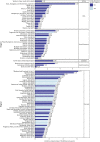Global Prevalence and Incidence of Amyotrophic Lateral Sclerosis: A Systematic Review
- PMID: 37308302
- PMCID: PMC10424837
- DOI: 10.1212/WNL.0000000000207474
Global Prevalence and Incidence of Amyotrophic Lateral Sclerosis: A Systematic Review
Abstract
Background and objectives: Amyotrophic lateral sclerosis (ALS) is a rare neurodegenerative disorder affecting upper and lower motor neurons. Due to its rarity and rapidly progressive nature, studying the epidemiology of ALS is challenging, and a comprehensive picture of the global burden of this disease is lacking. The objective of this systematic review was to describe the global incidence and prevalence of ALS.
Methods: We searched MEDLINE, Embase, Global Health, PsycInfo, Cochrane Library, and CINAHL to identify articles published between January 1, 2010, and May 6, 2021. Studies that were population based and reported estimates of prevalence, incidence, and/or mortality of ALS were eligible for inclusion. This study focuses on the incidence and prevalence. Quality assessment was performed using a tool developed to evaluate methodology relevant to prevalence and incidence studies. This review was registered with PROSPERO, CRD42021250559.
Results: This search generated 6,238 articles, of which 140 were selected for data extraction and quality assessment. Of these, 85 articles reported on the incidence and 61 on the prevalence of ALS. Incidence ranged from 0.26 per 100,000 person-years in Ecuador to 23.46 per 100,000 person-years in Japan. Point prevalence ranged from 1.57 per 100,000 in Iran to 11.80 per 100,000 in the United States. Many articles identified cases with ALS from multiple data sources.
Discussion: There is variation in reported incidence and prevalence estimates of ALS across the world. While registries are an important and powerful tool to quantify disease burden, such resources are not available everywhere. This results in gaps in reporting of the global epidemiology of ALS, as highlighted by the degree of variation (and quality) in estimates of incidence and prevalence reported in this review.
© 2023 American Academy of Neurology.
Conflict of interest statement
The authors report no relevant disclosures. Go to
Figures






References
-
- Richards D, Morren JA, Pioro EP. Time to diagnosis and factors affecting diagnostic delay in amyotrophic lateral sclerosis. In: Araki T, ed. Amyotrophic Lateral Sclerosis. Exon Publications; 2021. - PubMed
-
- Jennum P, Ibsen R, Pedersen SW, Kjellberg J. Mortality, health, social and economic consequences of amyotrophic lateral sclerosis: a controlled national study. J Neurol. 2013;260(3):785-793. - PubMed
Publication types
MeSH terms
LinkOut - more resources
Full Text Sources
Medical
Miscellaneous
